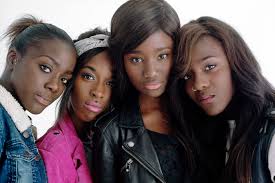In Céline Schiamma’s Girlhood, it’s all about the eyes.
Specifically, the eyes of Marieme (Karidja Touré), a quiet, reserved teen living in the Parisian projects. Throughout this excellent and unique coming-of-age film, Marieme goes through a number of phases and re-inventions, like we all do, but the constant is a singular sense of self we register in her eyes. Whether she’s skeptically surveying the local bad girls, both hesitant and drawn to them, or beaming as she and her new friends dance along to Rihanna in a hotel room, or flashing with anger at finding her younger sister poised to follow in her footsteps, Touré’s Marieme conveys it with a look. It’s a nuanced performance in a sensitive story.
Far more sensitive, really, than a film originally titled Bandes De Filles (Girl Gang) might lead you to expect. For once, the English-language title, though unfortunately implying it’s Boyhood’s Gallic cousin, gets it right.
We meet Marieme, and the film’s theme of created communities on the margins, in a clever fashion – playing all-girl’s football in full gear, a sight that probably doesn’t introduce too many movies. She lives in a tenement building with her strict, physically imposing older brother and her younger sister, herself on the cusp of adolescence.
In many ways, Schiamma’s set-up is classic slice-of-life stuff: Marieme has a crush on a local guy, who is also friends with her brother, and wants to protect her little sister as they try to make their lives work. She wants to get ahead and go to high school rather than vocational training, despite having already repeated a year. This is an economically depressed, absent-parent, kids-raising-themselves sort of situation familiar to fans of the Dardennes and others, but the unspoken, ever-present factor is race – in the early parts of the film, the only white people are implied off-camera or barely glimpsed, as in a conversation Marieme has with the school counselor. We never once cut to the counselor, the camera held in near close-up to Marieme, her longing and frustration in her voice and (where else?) her eyes.
Things begin to head in a different direction, though. For reasons that are left somewhat ambiguous – though surely related to escaping a stifling home life under brother’s thumb, and the more basic desire to get closer to the cute boy – Marieme falls in with Lady (Assa Sylla), Adiatou (Lindsay Karamoh), and Fily (Mariétou Touré), effectively forming the girl gang of the title. She starts bullying white girls for lunch money, killing time at the mall while pushing back at racist shopkeepers, and getting into fights, some more physical than others, with rival crews.
Tellingly, this vision of “gang” life is not characterized by guns so much as by sheer allegiance, like particularly fierce cliques. Rather than out-and-out criminal enterprises, these are more surrogate families based in general antagonism on the margins.
Schiamma’s narrative also emphasizes how important gender is to them, as well, and performative identity especially – a key scene (and a wonderful one) features the four of them dancing and singing along, in beautiful dresses and make-up, to the entirety of Rihanna’s “Diamonds”. It’s an unusually femmed-out sequence for an often gritty depiction of their lives, but the song’s endlessly repeatable hook – Eye to eye, so alive / We’re beautiful like diamonds in the sky – speaks wonderfully to the worlds the characters inhabit and to their longings, which really are less about boys and wealth than about safe spaces to be themselves. Lovingly shot in slightly unreal, video-ready filter and backlighting, the sequence is an exhilarating moment of release and relative freedom.
More self-creation follows, and more transformation. Marieme eventually falls in a crew of boys, who seem to accept her after she kicks the crap out of a rival, a harrowing sequence that also involves not only removing her fallen opponent’s tank top but cutting off her bra. This motif of exposure, vulnerability, and power is an evocative choice on Schiamma’s part, and fairly uncomfortable. The bra itself is like a war prize, which she holds aloft. A whole piece could be written about what’s going on here (and the ways it might both echo Marieme’s earlier advice to her sister to wear baggy clothes so her growing body won’t be noticed and foreshadow her own later attempts to alter her appearance), but regardless, it’s a striking theme.
By the film’s end, Marieme has gone through yet more reconstructions of look and identity. White people show up en masse for a single scene, at a party where she acts as a drug courier, wearing a blond wig and looking nothing like herself. She hides in her outfits, wigs, hairstyles, and shifting, situation-specific demeanor, but her eyes continue to betray a teenager without many options, racing to figure herself out.
The final third of the film begins to drag, raising questions it doesn’t have the time or inclination to really answer, but the whole of it is fascinating and compulsively watchable. People come and go from Marieme’s life in a way that’s both exaggerated and yet familiar – earlier friends simply aren’t mentioned again and choices that alienate her from family mean those people just aren’t around. As viewers, we coast along with Marieme, wondering what she’ll do next, and who she’ll grow to become.
After the closing credits, we still might be wondering, which is to the film’s credit. But her late decisions, and, as always, the look in her eyes, suggest both that she’s not done searching for herself, and that she might just be alright in the end, whoever she finds.



